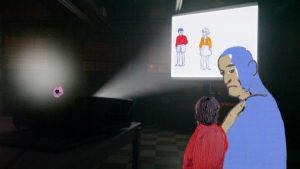Trance film is where a protagonist or a supporting character is in a dream like state, in other words imagine what is shown in the film to the audience. Watching the movie, a few things strike the eye first. From limb close-ups in the opening sequence to shadow illusions to the then-assumed fact that the protagonist is stuck in some sort of a time loop –only to find out that it’s just another illusion– to a distorted and decaying reality, to recurring items such as a key, a knife, and a record player, this movie portrays the idea of dream state in a unique way for its time. In this short analysis, I will try to explain these things from a personal perspective.
The movie starts with an arm extending through the sky, and dropping a flower on the ground. The protagonist reaches for the flower, grabs it, and through the reflection of her shadow on the wall, we see her smelling the flower as she walks towards a building. She climbs up the stairs, as reaches for her purse, pulls her key out. The key with the dramatic soundtrack banging with its every contact with the ground, falls down the stairs. She then grabs the key again, and enters the building. She acknowledges three items: a knife, a phone, and when she makes her way upstairs to the bathroom, a record player. She then scans the room, and falls asleep on the couch. Up until this point, a somewhat formula in shooting and narrative can be made: The shadow illusion as she walks towards her house; little-to-none portraits, merely her feet and items are clearly shown; a closing barrel like show to demonstrate the audience that the protagonist is in fact falling asleep. All checking the boxes of theory of causality and continuity. After this point, however, the things get a little bit Inception, so to speak. As the protagonist’s eyes close, she catches a glimpse of a woman in a dark robe walking towards the horizon on the road. In that instance, the camera moves back to the woman’s shadow, clearly chasing the woman in the robe. Within one more iteration, the protagonist finds herself in a time loop where she chases the woman in the robe, decides to enter the house and follow the same path of actions. But in each time, her former self, or a piece of her, is left in the bedroom. Also, this dreamlike state in which a time loop is active seems to decay with each iteration of itself. In second iteration, the protagonist catches a glimpse of the lady in the robe inside her bedroom, but as if she’s forcing things against the natural order, the climb up the stairs becomes a dreadful reality that’s physically warped to keep her away from her room. Right before the final act, the protagonist and her two former selves play a game. Each character belonging to different times grab a key in hopes of revealing who the lady in the robe is, and as the last iteration grabs the key, the itself is revealed to be a knife — which was in fact what they hoped to reveal with the game. She then grabs the knife, and moves to her sleeping self. As the last iteration of her dream state kills her, she wakes up to her husband asking her to sleep in her bed. In a series of events, she realizes, once again through the existence of “the knife” that she’s in fact in a dream that encapsulated her odd iterative dream state. As she breaks the mirror, it’s discovered by her husband, who casually walks into their house with the same kinda flower that got her into this mess, that she was in fact dead the whole time.
Personally, the fact that Maya Deren decided to use the score by Teiji Ito made the whole movie all the more meaningful. The way music kicks in during scenes is established early in the film, and it never changes throughout the film. In my opinion, this is particularly important, especially in a non-narrative silent film; the traditional movie follows a brief conclusion after the climax, but in this case, the previously established sound set gives the idea that there’s more to come (ie. second and third iterations). On another note, four step sequence where her third iteration has to fight her consciousness and travel through beach, grass, pavement, and rug surfaces is particularly an indicator as to human minds strengths on subconscious level. Overall, I’m not surprised that this movie was received the way it did. It has behavioral aspects that are both challenging and breathtaking, both of which are welcome. I wonder if Christopher Nolan had taken notes from this movie as his movie, Inception, clearly has some elements taken straight out of this film.



